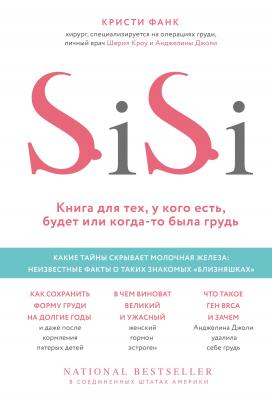SiSi. Книга для тех, у кого есть, будет или когда-то была грудь. Кристи Фанк
Читать онлайн.| Название | SiSi. Книга для тех, у кого есть, будет или когда-то была грудь |
|---|---|
| Автор произведения | Кристи Фанк |
| Жанр | Медицина |
| Серия | Красота в деталях. Научный подход к женскому здоровью |
| Издательство | Медицина |
| Год выпуска | 2018 |
| isbn | 978-5-04-099400-7 |
77
A. Castelló et al., “Spanish Mediterranean Diet and Other Dietary Patterns and Breast Cancer Risk: Case-Control EpiGEICAM Study,” British Journal of Cancer 111, no. 7 (2014): 1454–1462.
78
P. A. van den Brandt and M. Schulpen, “Mediterranean Diet Adherence and Risk of Postmenopausal Breast Cancer: Results of a Cohort Study and Meta-analysis,” International Journal of Cancer 140 (2017): 2220–2231.
79
G. Buckland et al., “Adherence to the Mediterranean Diet and Risk of Breast Cancer in the European Prospective Investigation into Cancer and Nutrition Cohort Study,” International Journal of Cancer 132, no. 12 (2013): 2918–2927.
80
K. Pintha, S. Yodkeeree, and P. Limtrakul, “Proanthocyanidin in Red Rice Inhibits MDA-MB-231 Breast Cancer Cell invasion via the Expression Control of Invasive Proteins,” Biological and Pharmaceutical Bulletin 38, no. 4 (2015): 571–581; E. A. Hudson et al., “Characterization of Potentially Chemopreventive Phenols in Extracts of Brown Rice That Inhibit the Growth of Human Breast and Colon Cancer Cells,” Cancer Epidemiology and Prevention Biomarkers 9, no. 11 (2000): 1163–1170; C. Hui et al., “Anticancer Activities of an Anthocyanin-Rich Extract from Black Rice Against Breast Cancer Cells In Vitro and In Vivo,” Nutrition and Cancer 62, no. 8 (2010): 1128–1136.
81
American Cancer Society, Breast Cancer Facts & Figures 2017–2018 (2017), открыто 2 декабря 2017 года, https://www.cancer.org/content/dam/cancer-org/research/cancer-facts-and-statistics/breast-cancer-facts-and-figures/breast-cancer-facts-and-figures-2017–2018.pdf.
82
American Institute for Cancer Research, брошюра Facts on Preventing Cancer: The Cancer Fighters in Your Food, открыто 26 декабря 2017 года, https://store.aicr.org/products/the-cancer-fighters-in-your-food.
83
. “5 Colors of Phytonutrients,” Naturally Healthy Concepts, открыто 26 декабря 2017 года, https://www.naturalhealthyconcepts.com/resources/infographics/phytonutrients; Office of Disease Prevention and Health Promotion, “Shifts Needed to Align with Healthy Eating Patterns,” in Dietary Guidelines for Americans 2015–2020, 8th ed., открыто 3 декабря 2017 года, https://health.gov/dietaryguidelines/2015/guidelines/chapter-2/a-closer-look-at-current-intakes-and-recommended-shifts.
84
C. B. Ambrosone et al., “Breast Cancer Risk in Premenopausal Women Is Inversely Associated with Consumption of Broccoli, a Source of Isothiocyanates, but Is Not Modified by GST Genotype,” The Journal of Nutrition 134, no. 5 (2004): 1134–1138.
85
Y. Li et al., “Sulforaphane, a Dietary Component of Broccoli / Broccoli Sprouts, Inhibits Breast Cancer Stem Cells,” Clinical Cancer Research 16, no. 9 (2010): 2580–2590.
86
J. J. Michnovicz, H. Adlercreutz, and H. L. Bradlow, “Changes in Levels of Urinary Estrogen Metabolites after Oral Indole-3-Carbinol Treatment in Humans,” Journal of the National Cancer Institute 89, no. 10 (1997): 718–723.
87
D. A. Boggs et al., “Fruit and Vegetable Intake in Relation to Risk of Breast Cancer in the Black Women’s Health Study,” American Journal of Epidemiology 172, no. 11 (2010): 1268–1279.
88
M. Gerber, “Fibre and Breast Cancer,” European Journal of Cancer Prevention 7, no. 2 (May 1998): S63–S67; L. A. Cohen, “Dietary Fiber and Breast Cancer,” AntiCancer Research 19, no. 5A (September – October 1999): 3685–3688.
89
S. Gandini et al., “Meta-analysis of Studies on Breast Cancer Risk and Diet: The Role of Fruit and Vegetable Consumption and the Intake of Associated Micronutrients,” European Journal of Cancer 36, no. 5 (March 2000): 636–646; T. T. Fung et al., “Diet Quality Is Associated with the Risk of Estrogen Receptor-Negative Breast Cancer in Postmenopausal Women,” Journal of Nutrition 136, no. 2 (February 2006): 466–472.
90
I. Mattisson et al., “Intakes of Plant Foods, Fibre and Fat and Risk of Breast Cancer: A Prospective Study in the Malmo Diet and Cancer Cohort,” British Journal of Cancer 90, no. 1 (January 2004): 122–127.
91
G. R. Howe et al., “Dietary Factors and Risk of Breast Cancer: Combined Analysis of 12 Case-Control Studies,” Journal of the National Cancer Institute 82, no. 7 (1990): 561–569.
92
A. Moshfegh, J. Goldman, and L. Cleveland, “What We Eat in America, NHANES 2001–2002: Usual Nutrient Intakes from Food Compared to Dietary Reference Intakes,” US Department of Agriculture, Agricultural Research Service 9 (2005).
93
G. D. Stoner, L. S. Wang, and B. C. Casto, “Laboratory and Clinical Studies of Cancer Chemoprevention by Antioxidants in Berries,” Carcinogenesis 29, no. 9 (2008): 1665–1674.
94
M. H. Carlsen et al., “The Total Antioxidant Content of More than 3,100 Foods, Beverages, Spices, Herbs and Supplements Used Worldwide,” Nutrition Journal 9, no. 1 (2010): 3.
95
C. Gerhauser, “Cancer Chemopreventive Potential of Apples, Apple Juice, and Apple Components,” Planta Medica 74, no. 13 (2008): 1608–1624.
96
S. Gallus et al., “Does an Apple a Day Keep The Oncologist Away?” Annals of Oncology 16, no. 11 (2005): 1841–1844.
97
K. Wolfe, W. Xianzhong, and R. H. Liu, “Antioxidant Activity of Apple Peels,” Journal of Agricultural and Food Chemistry 51, no. 3 (2003): 609–614.
98
E. Giovannucci, “Tomatoes, Tomato-Based Products, Lycopene, and Cancer: Review of the Epidemiologic Literature,” Journal of the National Cancer Institute 91, no. 4 (1999): 317–331; G. Masala et al., “Fruit and Vegetables Consumption and Breast Cancer Risk: The EPIC Italy study,” Breast Cancer Research and Treatment 132, no. 3 (2012): 1127–1136.
99
V. Dewanto et al., “Thermal Processing Enhances the Nutritional Value of Tomatoes by Increasing Total Antioxidant Activity,” Journal of Agricultural and Food Chemistry 50, no. 10 (2002): 3010–3014.
100
B. J. Grube et al., “White Button Mushroom Phytochemicals Inhibit Aromatase Activity and Breast Cancer Cell Proliferation,” The Journal of Nutrition 131, no. 12 (2001): 3288–3293.
101
M. Zhang, “Dietary Intakes of Mushrooms and Green Tea Combine to Reduce the Risk of Breast Cancer in Chinese Women,” International Journal of Cancer 124, no.
